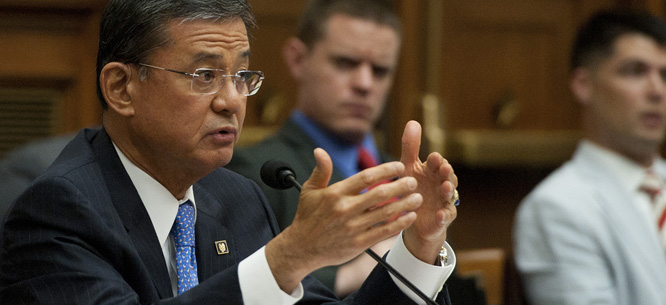Not a VA Scandal, But a War Scandal
Not a VA Scandal, But a War Scandal

President Obama is “madder than hell” at the Department of Veterans Affairs. At issue is whether VA hospitals in the Southwest and elsewhere used off-the-books lists to hide the fact that veterans often waited months to see doctors, dozens allegedly dying in the interim. And Eric Shinseki, the agency’s head, just lost his job as a result.
But Shinseki’s resignation won’t fix the problem. Nor will privatizing the VA, as a number of conservatives have called for. Nor even will rewriting VA policies, as leaders from both parties have vowed to do.
The core issue in this unfolding scandal is not one of corruption, of bureaucratic dysfunction, or of administrative incompetence, as it will no doubt continue to be presented. If it were, shaking up the agency might actually do some good. Instead, the problem is rooted in how we calculate the cost of war, which has consistently and dramatically underestimated the price of caring for the wounded.
Each year, VA hospitals grow more overwhelmed, often functioning less as healthcare facilities than as holding grounds for physically and psychologically damaged soldiers. This is not a new problem. Although the wars in Iraq and Afghanistan have exacerbated the challenges faced by VA facilities, these problems have existed for decades. The problem persists, however, because it is largely invisible to the public.
But it wasn’t invisible to me.
I spent much of my youth in Los Angeles–area VA facilities with my father, who bore the physical and psychological scars of combat. Like most veterans, the outpatient treatment he received was generally good, and often meant moving through brightly lit and recently updated facilities. Yet as his health continued to fail, my father needed more intensive care. And getting him that care required a constant uphill struggle—to get information about the care available, to place him on the right waiting lists, and to prove the seriousness of his illness. It also meant leaving him each night in a forgotten bungalow on a vast VA campus, wondering what the future held.
Others suffered, too. My father’s first roommate—in a seemingly off-the-books VA nursing home not entirely unlike the infamous Building 18 at Walter Reed Army Medical Center—waited for weeks to have his leg removed. The entire ward knew the smell of gangrene. His second roommate often left the room in the middle of the night, not to return for several days. A nurse confided that they didn’t have the manpower to keep track of him; one night he left and never came back.
To be clear: these veterans did not suffer in the hands of incapable doctors and nurses. Many VA personnel are among the best in the world, and many have foregone lucrative careers in the private sector in order to serve veterans.
Instead, these men and women suffered because their collective needs were too numerous to be adequately addressed by the existing system—something most Americans, and even many of our political leaders, are unaware of.
In the past decade, as we have carried on two active wars, the demands on VA facilities have risen sharply. But as veterans from other wars age and experience complex health problems—often related to their military service—they, too, are requiring additional treatment. Thus, as the number of VA patients increases, the organization’s ability to deliver appropriate care continues to diminish.
I am not surprised to hear that the VA may have been keeping two sets of books. I’ve seen entire buildings that seemed to function as open secrets. Nor am I surprised to hear that VA hospitals are not equipped to meet demand. The night my father died, it was in an ambulance rushing him out of a VA facility because they lacked adequate resources.
Perhaps least surprising of all, however, is how this latest tragedy is unfolding—as a scandal rather than as a call for action.
The conflicts in Iraq and Afghanistan have cost nearly $4 trillion over the past decade. But even that enormous figure conceals the true cost of war. Because the truth is that adequate treatment for our veterans—men and women with a wide variety of health needs, many of which will never go away—is far more costly than the VA’s current budget will allow for. In fact, according to the Congressional Budget Office, treating all veterans under current guidelines will require as much as a 75 percent increase in funding for the VA between 2010 and 2020—yet even that figure fails to address whether such treatment will be sufficient.
Ultimately, this isn’t a VA scandal. It’s a war scandal. Because the true cost of war includes paying to care for those who return from the fight. And if we aren’t willing to do that, we need to stop sending them into harm’s way.
Jack Schneider is an assistant professor of education at the College of the Holy Cross in Massachusetts, and the son of a deceased veteran. You can follow him on Twitter @Edu_Historian.





